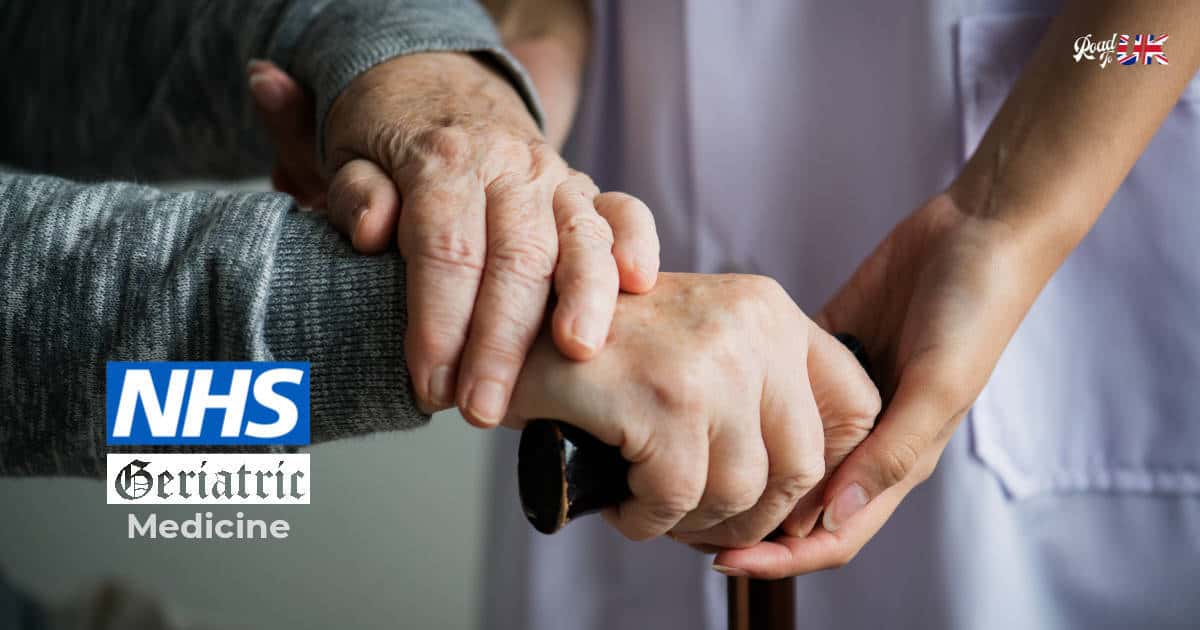Working in Geriatric Medicine in the NHS

Geriatrics, or care of the elderly, may initially strike you as a boring rotation. You might think it’s just a ward of falls and dementia, but to be perfectly honest, working in geriatric medicine is like experiencing a true medicine ward. A patient can come in with any possible presentation and it is your job to determine what is making them ill.
What is Geriatric Medicine?
First you need to understand what qualifies a geriatric patient. Generally 65 and above is considered eligible for a geriatric ward, but fraility plays a major role in this classification. If a patient is younger but perceived as frail, they may still be admitted to a geriatric ward.
As mentioned before, care of the elderly is a mixed bag of patients where you can find patients suffering from pneumonia, vasovagal syncope, stroke, dementia, Parkinson’s, Alzheimer’s, falls, urinary incontinence, UTIs, etc.
An important thing to keep in mind as you assess your patient is the Rockwood’s Clinical Fraility Score:

Daily tasks on a geriatric medicine ward
Geriatrics is a fairly hands-on ward. You’ll be expected to:
- Take bloods (depends on the workforce in your hospital)
- Insert catheters
- Conduct memory tests like Montreal Cognitive Assessment (MoCA) and Addenbrooke’s Cognitive Examination- Third Edition (ACE-III)
- Take a comprehensive history to understand the patient’s situation
- Assess and implement Deprivation of Liberty Safeguards (DoLS)
- Highlight any social issues you perceive the patient might have, such as their inability to properly care for themselves
Care of the elderly is very much a multi-disciplinary (MDT) led ward. Apart from the obvious close working with the nursing staff, you will also need the input of dietitians, physiotherapists, occupational therapists, discharge liaison/managers, and consultants from other specialties such as gastroenterology, cardiology, neurology, etc. All of this adds to what they do as a comprehensive geriatric assessment (CGA).
Things to know on the ward
Aside from what’s been mentioned above, you should be well-versed in the types of medications that should be avoided in the elderly, scope out any signs of depression with the Geriatric Depression Scale (GDS), how to approach patients with dementia, and how to relay information to a patient’s family.
Often times you may find yourself in a situation where the patient has been placed under DoLS and/or has given power of attorney to a family member/friend. In these cases, you will need to explain why the patient has been put under a DoLS and what that would entail.
Clinically familiarize yourself with Geriatric Giants
In 1965, Bernard Isaacs coined the term ‘geriatric giants’. Professor Isaacs named these ‘giants’ as immobility, instability, incontinence, and impaired intellect/memory.
These ‘giants’ have changed over the past 50 years. The understanding of ‘modern geriatric giants’ has evolved to further encompass four new syndromes. They are frailty, sarcopenia, the anorexia of ageing, and cognitive impairment.
What is a DoLS?
As mentioned before, DoLS stands for the deprivation of liberty safeguards. Now, what does that exactly mean? As a patient, and a person, we are afforded autonomy and the capacity to do as we please in regards to our care. We can opt to not continue treatment and self-discharge. We can refuse certain medications and procedures. This is all granted that we are deemed to have the mental capacity to do this.
Unfortunately, there are medical conditions that can affect this capacity and it can be difficult to treat a patient. It’s for this reason, in their best interests, we implement DoLS, which essentially requires us to obtain permission after reviewing the situation and assessing the patient. The following things fall within the purview of DoLS (this list is not exhaustive):
- Continuous supervision
- Not free to leave the ward
- Treatments and care done as best interest
How to assess mental capacity?
You may have noticed that above I mentioned that we must first understand if an individual has capacity before we decide to proceed with care. So what can be done to assess capacity?
- They must understand the information given to them (ex: We need to give you these antibiotics because you have pneumonia.)
- They must be able to remember or retain the information given to them in order to make a decision regarding their care (ex: Do you recall our discussion as to why we want to give you antibiotics?)
- They must be able to fully comprehend the pros and cons of their decision (ex: If we choose to give this antibiotic versus another one, you may experience these side effects.)
- They must be able to communicate the decision they have made to you
If a patient ticks all the boxes mentioned above, they are deemed to have capacity. If a patient does not have the capacity and has no next of kin (NOK), there may be an implementation of an Independent Mental Capacity Advocate (IMCA).
What is an IMCA?
As mentioned before, independent mental capacity advocates (IMCA) are called in to help patients who are deemed to not have the capacity and have no next of kin to speak to in order to understand what the patient would want. An IMCA advocate on the patient’s behalf, and should be contacted if the patient is facing the prospect of serious medical treatment for which they cannot consent. They ensure that the patient’s rights are maintained and upheld and that they are involved in the entire decision-making process.
Breaking Bad News
As a junior doctor, you should never be put in the position where you alone are breaking bad news to a patient, but at the same time, you should not shirk away from the opportunity to sit in on a registrar or consultant doing so. If appropriate, you can also speak to your registrar or consultant to allow you to participate in these discussions when you feel confident to do so.
While initially, the prospect of sitting patients with their family or even perhaps just speaking to family alone (with permission if needed) can seem difficult or near about impossible, it is a skill that is vital to have. Families (and nurses!) appreciate doctors who communicate well, and an essential part of that communication is often knowing how to properly break bad news.
There isn’t any perfect way (at least in my opinion) to do it, and I’ve found that initially we will all stumble and hem and haw when put on the spot, so it’s a good idea to observe as many senior doctors following through as you can. This will give you a foundation to build upon your own experience and you will have a starting point. If you can, try and sit with another doctor and hold practice sessions on how you’d speak to a patient.
It’s always a good idea to give this type of information in a private setting, so if the patient isn’t already in a side room, try and see if something can be arranged. If the family are there, brief them of what’s been done so far. Keep as much of your team there as possible- the nurse who has been looking after the patient, the nurse in charge, any other doctors immediately involved in their care, etc. If appropriate, see if you can arrange for a nurse or doctor from palliative care to be there as well.
The most important part of this entire process is hearing the patient and their family out. They may have many questions and concerns, and it is our duty to alleviate their worries as best we can. If ever you are put into a situation where you are asked something that you do not have the answer to, please refrain from providing false hope or unsure responses. Instead, explain that you are not certain and that you will try and find out and get back to them.
What is EOL & LDOL?
End of life care (EOL) and last days of life (LDOL) are interchangeable terms. Despite our best efforts, sometimes you may find that patients in your geriatric medicine ward are not improving or recovering. It can become clear that they are nearing the end of their life, and as their healthcare provider, it is our responsibility to ensure their dignity is maintained and their wishes upheld.
Before this type of pathway is put into place, it’s something that needs to be thoroughly weighed and discussed with the family. There is paperwork that should be completed regarding the pathway, and with it comes a list of medications to be prescribed. These medications don’t all need to be prescribed at once; only prescribe what is appropriate given the patient’s current situation and the others can be left as needed (PRN). If you are going to be prescribing regular medications as per the EOL pathway, all unnecessary medications are struck off, IV fluids stopped, and comfort care measures and medications are started. The regular medications that are to be given will be administered by a syringe driver, which provides subcutaneous medication over 24 hours.
How to get into geriatrics training?
If you wish to pursue geriatric medicine as a speciality, and you meet the qualifications for Internal Medicine Training (IMT), you can apply for it. As this speciality is defined as acute, you would only need to complete three years of IMT. Upon completion of IMT, you would then apply for a specialty training post in geriatrics.
Alternatively, if you have already completed MRCP and wish to apply directly into specialty training, you may do so as long as your core competencies are signed off.
Still have questions?
Check out the insight given into the field by a consultant in geriatric medicine:
If you have any other concerns about starting your new job, don’t hesitate to check out Your First Day on the Job as well as Role of a Junior Doctor in the NHS.

